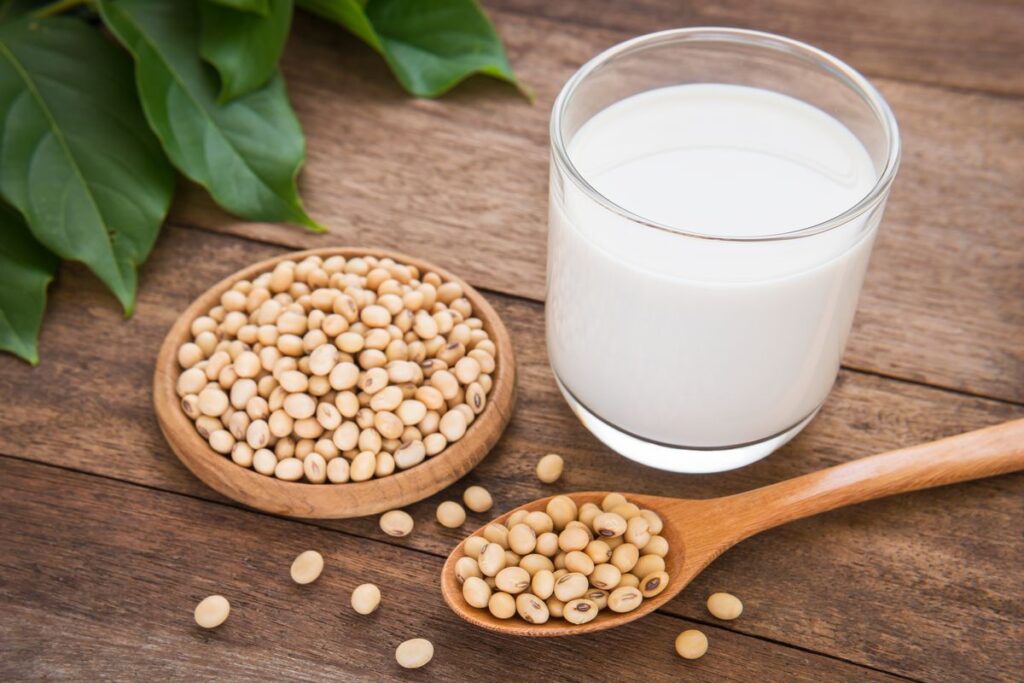
The soy beverage market value is expected to rise from USD 24,412 million in 2024 to USD 42,167 million by 2034. This market is analyzed to record a CAGR of 5.6% over the next decade.
The growing interest in vegan and vegetarian diets is pushing the consumption of soy beverages. Soy beverages also hold significant appeal among lactose-intolerant consumers due to their favorable constituents.
Consumption of soy milk helps improve heart health, reduce the risk of osteoporosis, and lower the chances of diabetes. On the back of these benefits, dieticians and health professionals are recommending relevant people to drink soy beverages.
Request a Sample of this Report Now
To increase their consumer base, players are offering unsweetened handcrafted organic soy drinks that are made with organic soybeans immersed in RO water. Additionally, they are crafting soy drinks in small batches. The artisanal process of players ensures the product is replete with protein and bursting with flavor.
The clean label on the product offering ensures that consumer has complete knowledge about the product they are consuming. This includes information about salts, additives, preservatives, sugars, additives, emulsifiers, oils, or artificial flavors.
Manufacturers are taking precautions so that soy milk does not curdle in a short period, making it a brilliant choice for coffee or tea. For this, the beverage is fortified with protein-rich content. Players are also ensuring that their soy drink is shelf-stable, making refrigeration unnecessary.
Key Takeaways from the Soy Beverage Market Report
- The global soy beverage market is projected to total USD 42,167 million by 2034.
- Soy milk segment is projected to account for a share of 64.6% in 2024.
- The flavored soy beverage is predicted to hold a market share of 56.8% in 2024.
- Canada is set to record a 5.9% CAGR over the forecast period.
- Sales in Spain are anticipated to grow at a CAGR of 11.2% through 2034.
“Players are focusing on sustainable soy farming practices and evolving consumer tastes and preferences to increase their share,” says a lead analyst of Future Market Insights (FMI).
Who is Winning?
Industry participants are developing lactose-free, vegan, and organic beverage options, to meet the dietary requirements of diversified consumer demographics. They are also introducing soy milk fortified with additional nutrients like calcium, vitamin D, and protein blends to gain acceptance among health-conscious consumers.
Players are further adopting sustainable soy farming practices by curtailing their water usage. Consequently, they are gaining appeal among eco-conscious consumers. Players are also collaborating with varied plant-based food and beverage firms to increase their market reach.
Recent Developments in the Soy Beverage Market
- Yeo Hiap Seng, which is a Singapore-based company, launched a unique soy milk beverage in the region in April 2024. The product is fortified with vitamin B6 and zinc to elevate the body’s immunity.
- The Fresh Barista Soya Drink made its debut in January 2024. The product is constituted of sustainably sourced, non-GMO soy.
Get More Valuable Insights
Future Market Insights (FMI), in its new offering, provides a thorough, detailed, and unbiased analysis of the global soy beverage market, presenting historical demand data for the years 2019 to 2023 and forecast statistics for the years 2024 to 2034.
The study provides compelling industry insights based on the product type (soy milk and soy drinkable yogurt), flavor (flavored soy beverage and unflavored soy beverage), and sales channel (offline sales channel {supermarkets/hypermarkets, departmental stores, convenience Store, and other sales channels) and online sales channel (company website and eCommerce platform)} across several regions.
Click Here To Purchase Your Full Report
Key Segments of Soy Beverage Market
By Product Type:
The soy beverage market segmentation, based on product type, is divided into soy milk and soy drinkable yogurt.
By Flavor:
The industry is categorized as flavored and unflavored soy beverages, on the basis of flavor.
By Sales Channel:
Key sales channels that distribute this product include offline sales channels and online sales channels. The offline sales channel is further divided into supermarkets/hypermarkets, departmental stores, convenience stores, and other sales channel. The online sales channel is divided into eCommerce platforms and company websites.
By Region:
Sales trends of the product in regions like North America, Latin America, Europe, East Asia, South Asia, Middle East and Africa (MEA), and Oceania are inspected in the report.
About Future Market Insights (FMI)
Future Market Insights, Inc. (ESOMAR certified, recipient of the Stevie Award, and a member of the Greater New York Chamber of Commerce) offers profound insights into the driving factors that are boosting demand in the market. FMI stands as the leading global provider of market intelligence, advisory services, consulting, and events for the Packaging, Food and Beverage, Consumer Technology, Healthcare, Industrial, and Chemicals markets. With a vast team of over 400 analysts worldwide, FMI provides global, regional, and local expertise on diverse domains and industry trends across more than 110 countries.
Contact FMI:
Future Market Insights Inc.
Christiana Corporate, 200 Continental Drive,
Suite 401, Newark, Delaware – 19713, USA
T: +1-845-579-5705
For Sales Enquiries: sales@futuremarketinsights.com
Website: https://www.futuremarketinsights.com
LinkedIn| Twitter| Blogs | YouTube